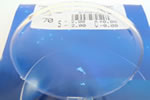Astigmatism Prescription
by Mark
Q: How can I read this astigmatism prescription?
So I tried out new glasses, the first pair of my life, for about a week. Everything looked terrible; fine detail like text was clearer, but people looked like dwarfs and their faces looked like trapezoids.
Also, the left eye seemed to be magnified more than the right, making things seem like I couldn't quite focus on them correctly. When I took the glasses off, it took me a solid 30 mins to adjust, and my left eye almost felt cross-eyed. With my naked eyes, I swear that my eyes see exactly the same when I close one or the other.
I went back to the doctor and he gave me a spiel about how I was seeing the real world now with the new glasses, but I finally talked him down to 50% of the prescription, and he said he was previously giving my left eye 125% and my right eye 100%, which I said I was noticing and greatly disliked. My new prescription is as follows:
OD Pl -50 x125
OS Pl -50 x045
I have no idea what these numbers mean, especially the wildly diverging x125 and x045. Do those asymmetrical numbers have anything to do with how much "strength" each lens has, or something else?
A: I must say from the beginning that it is not easy to accommodate for astigmatism, especially if it is your first pair of glasses. Eye needs adjusting, and it happens slowly over time. Therefore, the first pair of glasses must have a lower diopter and it will grow to the next consultation.
If you get your first pair of glasses with maximum diopters, will happen what you described already above, namely you will not be able to get used to these glasses. It is best to start slowly and reach the final result in time.
To understand your astigmatism prescription, you should know that the astigmatism correction is made by the cylindrical lens. This is a particular lens that is not uniform over the entire surface and therefore must be placed in a certain position, in front of your eye.
This position is determined by the axis of the cylinder. Axis can be between 0 and 180 degrees.
First value on your prescription is the diopter (-0.50)
The second value is the axis (125 degrees or 45 degrees).
Generally, the axis varies barely in time, but diopters can grow. The strength as you said, is determined only by the diopter, the axis will indicate the position of the diopter in the lens.
Hope this helps,
Arpi
Comments for Astigmatism Prescription
|
||
|
||
|
||
|
Click here to add your own comments Join in and write your own page! It's easy to do. How? Simply click here to return to FAQ. |
Was this information useful?
1. Like Perfect-Eyeglasses-Guide.com on Facebook.
2. Share this article with your friends:




